Abstract
Two experiments were performed to investigate the effects on pigeons' keypecking behavior of stimuli that signal different kinds of aversive events: time-out from positive reinforcement, electric shock, loud noise, and loud tone. Behavior maintained by a variable-interval schedule of reinforcement was suppressed by a stimulus before shock, was accelerated by a stimulus before time-out from positive reinforcement, and was unchanged by a stimulus before loud noise or a stimulus before loud tone. Conditioned acceleration with time-out from positive reinforcement and conditioned suppression with shock were obtained regardless of whether a response contingent or response-independent procedure was employed.
Full text
PDF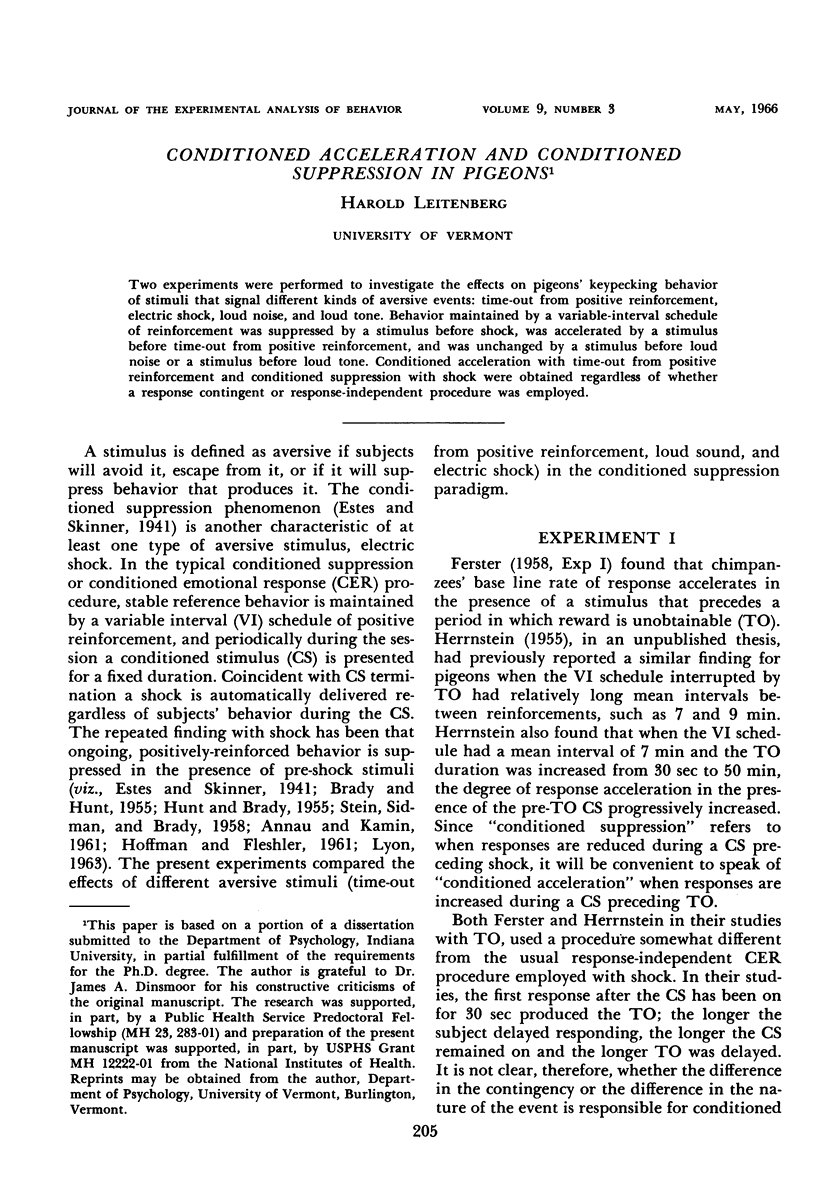

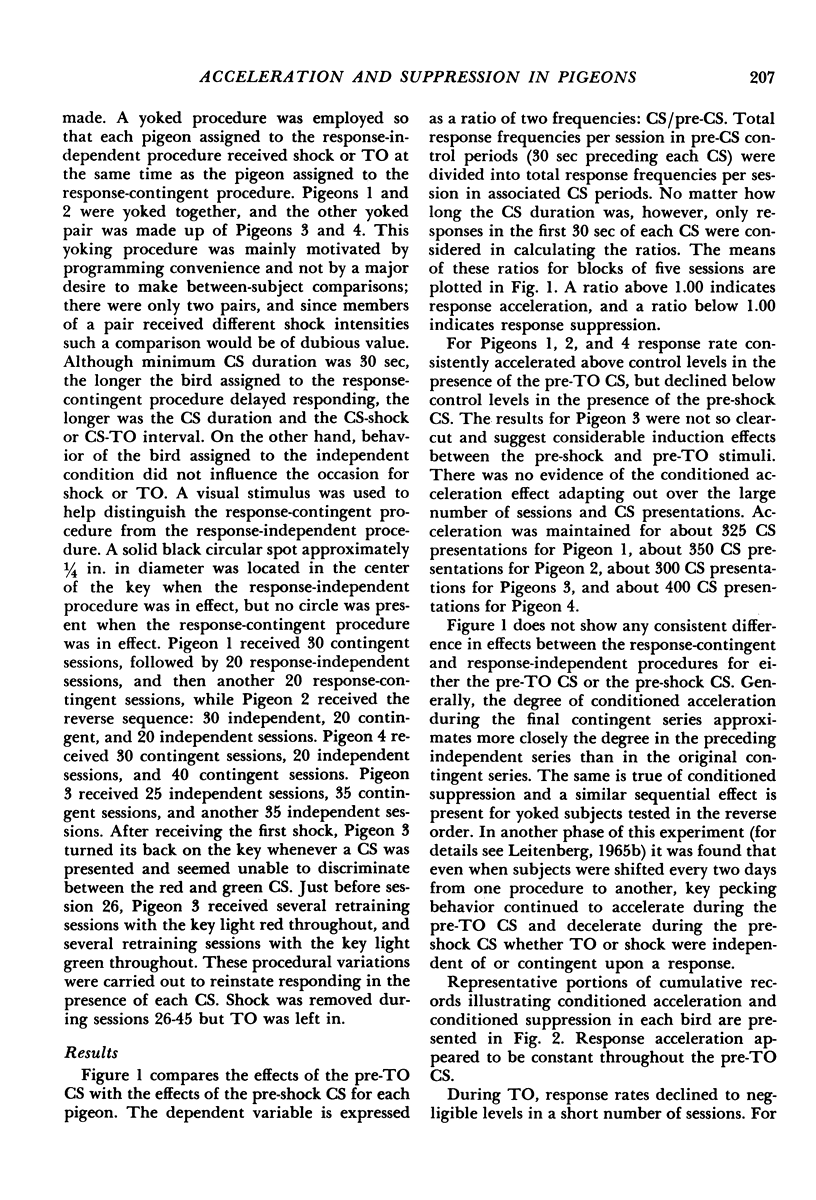

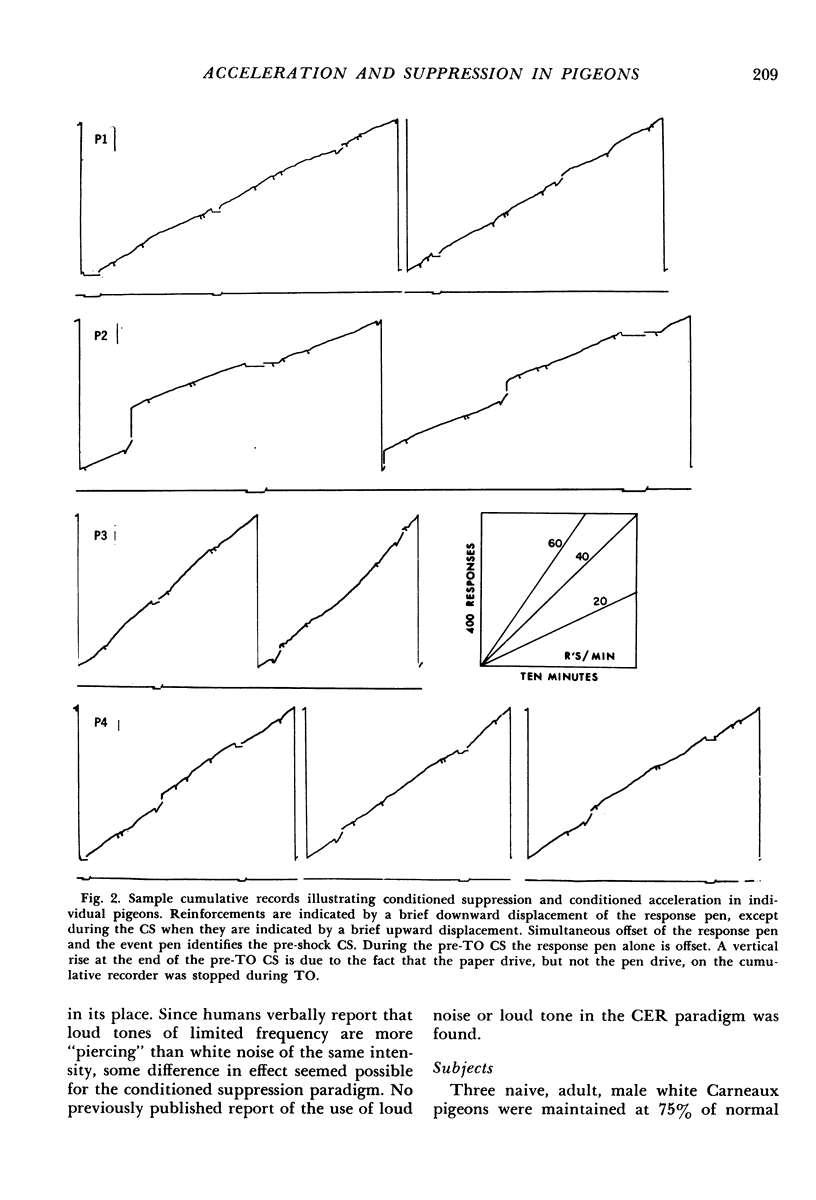

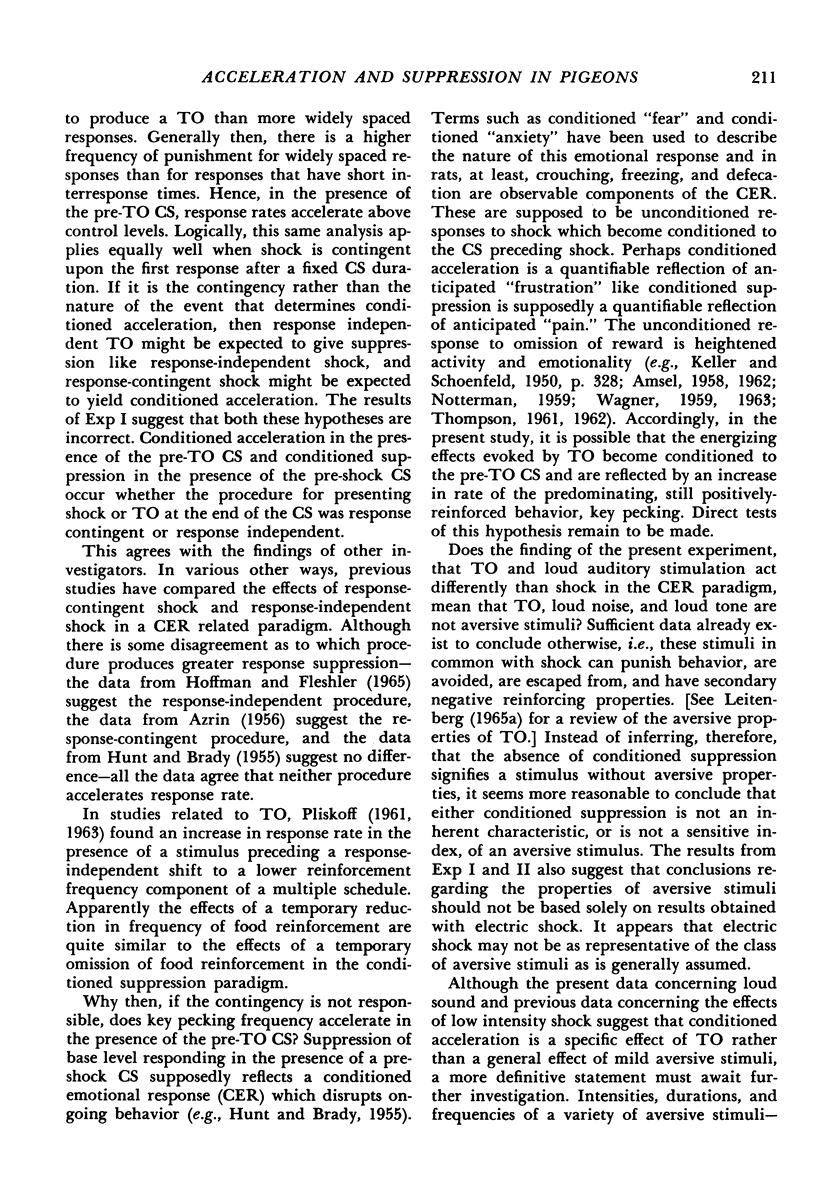
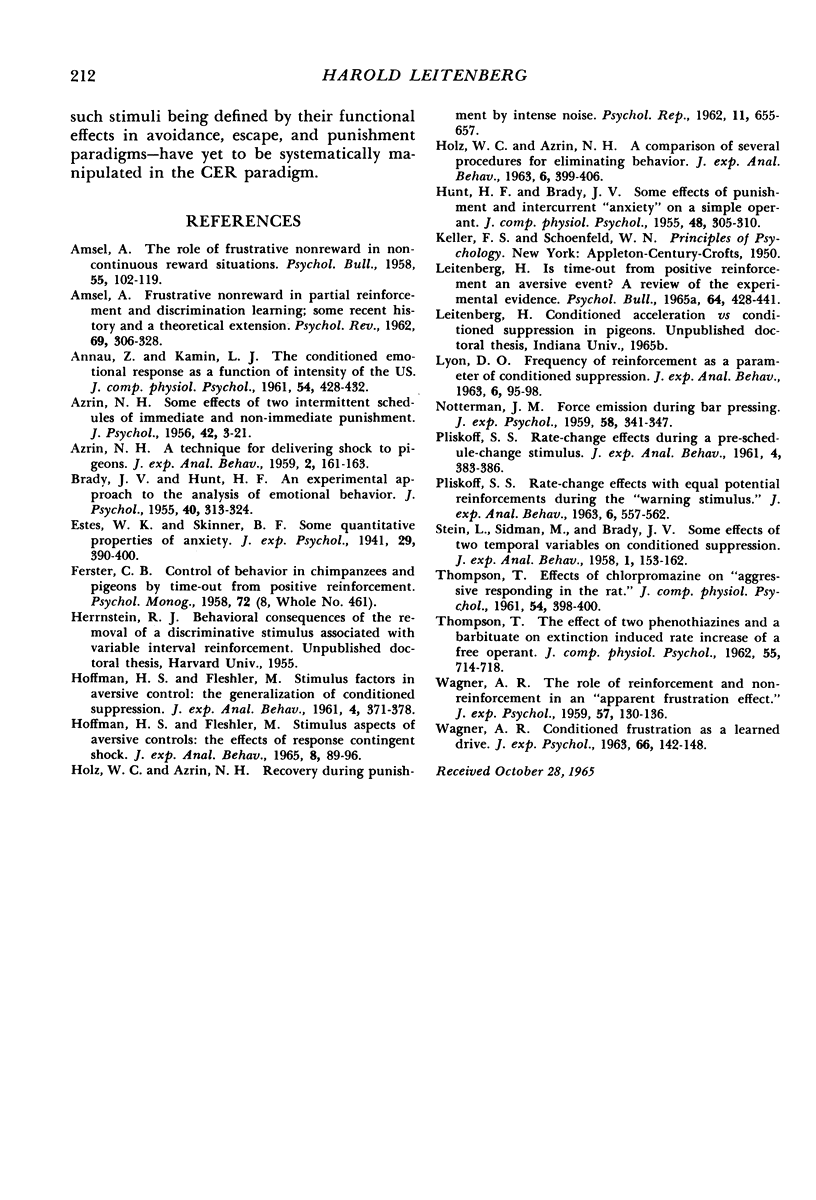
Selected References
These references are in PubMed. This may not be the complete list of references from this article.
- AMSEL A. Frustrative nonreward in partial reinforcement and discrimination learning: some recent history and a theoretical extension. Psychol Rev. 1962 Jul;69:306–328. doi: 10.1037/h0046200. [DOI] [PubMed] [Google Scholar]
- AMSEL A. The role of frustrative nonreward in noncontinuous reward situations. Psychol Bull. 1958 Mar;55(2):102–119. doi: 10.1037/h0043125. [DOI] [PubMed] [Google Scholar]
- ANNAU Z., KAMIN L. J. The conditioned emotional response as a function of intensity of the US. J Comp Physiol Psychol. 1961 Aug;54:428–432. doi: 10.1037/h0042199. [DOI] [PubMed] [Google Scholar]
- AZRIN N. H. A technique for delivering shock to pigeons. J Exp Anal Behav. 1959 Apr;2:161–163. doi: 10.1901/jeab.1959.2-161. [DOI] [PMC free article] [PubMed] [Google Scholar]
- HOFFMAN H. S., FLESHLER M. STIMULUS ASPECTS OF AVERSIVE CONTROLS: THE EFFECTS OF RESPONSE CONTINGENT SHOCK. J Exp Anal Behav. 1965 Mar;8:89–96. doi: 10.1901/jeab.1965.8-89. [DOI] [PMC free article] [PubMed] [Google Scholar]
- HOFFMAN H. S., FLESHLER M. Stimulus factors in aversive controls: the generalization of conditioned suppression. J Exp Anal Behav. 1961 Oct;4:371–378. doi: 10.1901/jeab.1961.4-371. [DOI] [PMC free article] [PubMed] [Google Scholar]
- HOLZ W. C., AZRIN N. H. A comparison of several procedures for eliminating behavior. J Exp Anal Behav. 1963 Jul;6:399–406. doi: 10.1901/jeab.1963.6-399. [DOI] [PMC free article] [PubMed] [Google Scholar]
- HUNT H. F., BRADY J. V. Some effects of punishment and intercurrent anxiety on a simple operant. J Comp Physiol Psychol. 1955 Aug;48(4):305–310. doi: 10.1037/h0042529. [DOI] [PubMed] [Google Scholar]
- LYON D. O. Frequency of reinforcement as a parameter of conditioned suppression. J Exp Anal Behav. 1963 Jan;6:95–98. doi: 10.1901/jeab.1963.6-95. [DOI] [PMC free article] [PubMed] [Google Scholar]
- Leitenberg H. Is time-out from positive reinforcement an aversive event? A review of the experimental evidence. Psychol Bull. 1965 Dec;64(6):428–441. doi: 10.1037/h0022657. [DOI] [PubMed] [Google Scholar]
- NOTTERMAN J. M. Force emission during bar pressing. J Exp Psychol. 1959 Nov;58:341–347. doi: 10.1037/h0042801. [DOI] [PubMed] [Google Scholar]
- PLISKOFF S. S. RATE-CHANGE EFFECTS WITH EQUAL POTENTIAL REINFORCEMENTS DURING THE "WARNING" STIMULUS. J Exp Anal Behav. 1963 Oct;6:557–562. doi: 10.1901/jeab.1963.6-557. [DOI] [PMC free article] [PubMed] [Google Scholar]
- PLISKOFF S. Rate-change effects during a pre-schedule-change stimulus. J Exp Anal Behav. 1961 Oct;4:383–386. doi: 10.1901/jeab.1961.4-383. [DOI] [PMC free article] [PubMed] [Google Scholar]
- Stein L., Sidman M., Brady J. V. Some effects of Two Temporal Variables on Conditioned Suppression. J Exp Anal Behav. 1958 Apr;1(2):153–162. doi: 10.1901/jeab.1958.1-153. [DOI] [PMC free article] [PubMed] [Google Scholar]
- THOMPSON T. Effect of chlorpromazine on "aggressive" responding in the rat. J Comp Physiol Psychol. 1961 Aug;54:398–400. doi: 10.1037/h0048753. [DOI] [PubMed] [Google Scholar]
- THOMPSON T. The effect of two phenothiazines and a barbiturate on extinction-induced rate increase of a free operant. J Comp Physiol Psychol. 1962 Oct;55:714–718. doi: 10.1037/h0042626. [DOI] [PubMed] [Google Scholar]
- WAGNER A. R. Conditioned frustration as a learned drive. J Exp Psychol. 1963 Aug;66:142–148. doi: 10.1037/h0047714. [DOI] [PubMed] [Google Scholar]
- WAGNER A. R. The role of reinforcement and nonreinforcement in an apparent frustration effect. J Exp Psychol. 1959 Feb;57(2):130–136. doi: 10.1037/h0047041. [DOI] [PubMed] [Google Scholar]


